#ucla department of special collections
Photo

“Two Runaway Girls Say They Will Do It Again,” Los Angeles Times, Oct 4, 1935
#1930s#1930s fashion#vintage fashion#los angeles#vintage#old los angeles#los angeles times#great depression#photography#black and white#photo restoration#ucla department of special collections#los angeles times photographic collection#ark:/21198/zz002dgx0c
467 notes
·
View notes
Text
BLOGTOBER 10/26/2022: TERRIFIER 2 (and various other TERRIFIERS)
I've been trying to wrap my head around the Art the Clown phenomenon for a minute now, and I may be developing a kind of begrudging respect for it, but I still don't know if I really get it. The thing that keeps me from dismissing it outright as just a bunch of edgelord nonsense is that even at their worst, these movies seem like a ton of work to make, featuring elaborate gore gags that would be a huge pain in the ass for a small, independent crew to create. On their tiny budgetary scale, movies like ALL HALLOW'S EVE and TERRIFIER 1 & 2 really have to run on love and desire, which I think are the most important ingredients in any production. What I struggle with is the everything-else part: I'm not sure these movies are motivated by anything other than the urge to offend, which is kind of lame when it stands alone. The best thing about them for me, personally, is that they challenge me to question if I really am offended by them for reasons other than their prurient nature—and if so, how and why.
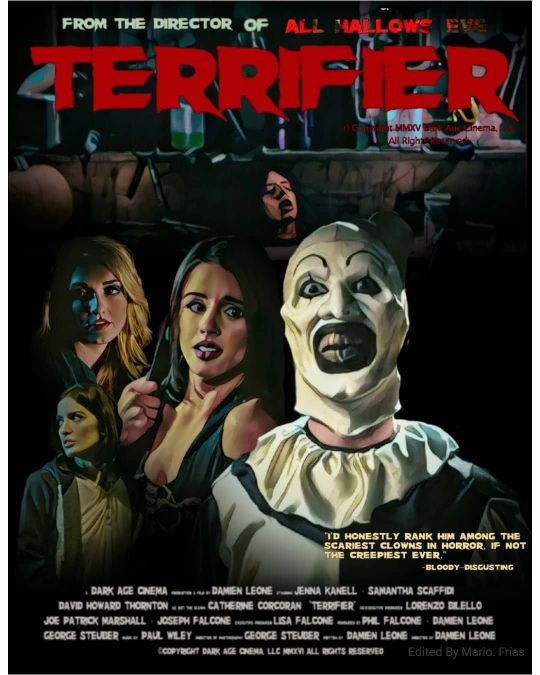
The Art the Clown trilogy is less like a collection of three movies starring a central character, and more like a single movie that has been gestating over the course of three releases. TERRIFIER 2 is inarguably the most creative and mature (am I really saying this?) of the three, amalgamating choice elements of its two predecessors into something that is more like a "real movie" and less like an excuse to try out a bunch of fucked-up ideas. And I don't mean to shit on the idea of making a movie as a sandbox for special effects; people have been doing that from the earliest origins of the horror genre. But, there's something a little different about modern projects that should benefit from the films that have gone before. I find it hard not to judge movies a little more harshly if they've come out during my own lifetime. I assume that those filmmakers know what I know, and I might expect them to use that knowledge a certain way.
When Joe Bob Briggs ran John Carpenter's HALLOWEEN on The Last Drive-In, he remarked (approximately) that it was the first time a violent slasher movie starred a psychopath, where audiences didn't have to worry that the film itself was made BY psychopaths, unlike the gnarlier material that circulated in the Times Square grindhouses of the 1970s. HALLOWEEN was obviously made by UCLA-trained professionals with mainstream aspirations, and if it suffered from accusations of misogyny and sadism, this was because it was being compared to more mainstream fare by people who saw it in suburban theaters; those critics didn't have the context of the world's many LAST HOUSEs (ON THE LEFT, or ON DEAD END STREET, or wherever), movies made by former pornographers and angry young men whose main motivation, besides making a quick and dirty buck, was just to be extremely antisocial. As a modern viewer, when I watch something like HOUSE ON THE EDGE OF THE PARK, I understand that it comes from a different universe than the one I live in; it's darker, more desperate, forged by different historical and socioeconomic forces, and I relish the opportunity to delve into that psycho-social space without being directly subjected to the grim reality from whence it came. It's all sort of academic for me. Nowadays, people who make really antisocial movies are all nerds; their movies tend to be an act of fandom, and even if they're trying to one-up young Sam Raimi or Peter Jackson in the fucked-uppedness department, you can tell where they're coming from culturally. You don't have to risk life and limb to see their movies in the woebegone grindhouses of yesteryear, and if you've even heard of them, you're probably a nerd, too. All this can make these productions less threatening and more familiar, regardless of how demented their content is.
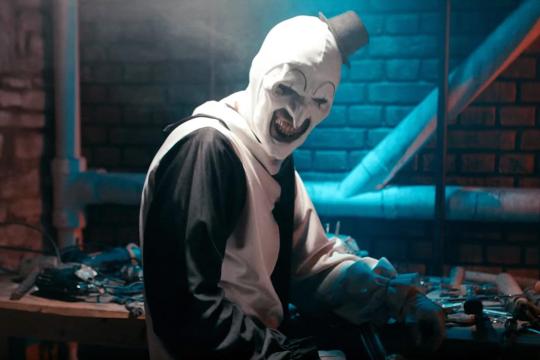
As a brief aside, though: Apparently there are reports going around of people vomiting and fainting in theatrical audiences for TERRIFIER 2, and who knows if that's true or just an exciting rumor, but it's astounding to me that A) a movie like this is playing in the kinds of theaters that serve vulnerable normie viewers to begin with, and b) the rumor of this visceral audience response has been repeated in USA Today. I mean when I was growing up, if something like EVIL DEAD or DEAD ALIVE turned up in an extremely mainstream publication, it would be because of the Satanic Panic, it would be because the 700 Club was going after it or something. And in my mind, the TERRIFIER series is in a sub-basement way beneath the level of EVIL DEAD; it's from a grimy, underground place that's barely even connected to the world where fans of SCREAM or Chucky live. The fact that it's in movie theaters when fewer and fewer films are getting theatrical releases at all is wild enough to me, but a spotlight in USA Today is way, way beyond my comprehension. It's like if Olaf Ittenbach's BURNING MOON were reviewed by Leonard Maltin. I almost love that this is happening. It's like, am I on another planet?
Anyway.
Where was I?
Oh yeah, whether it's fair or not, I tend to hold modern creators of "fucked up" movies to a different standard than their predecessors. I think the new kids can be accused of lacking the innocence of the exploitation artists of previous decades. Someone like Herschell Gordon Lewis would have been aware of the rising tide of social change, but he wasn't raised with political correctness as the norm; he was an entrepreneur who knew that the then-new splatter subgenre would be a must-see novelty for contemporary audiences. And, on some level, misogynistic anger was ordinary and unquestioned. On the other hand, when you make a movie in 2016 at the beginning of the Trump era where a crazed killer saws a teenage girl in half vagina-first, it has a different vibe. The ironic pleasure of seeing a really uninhibited film from a more ignorant era is nowhere to be found, and you have to ask yourself: What the fuck is this movie's problem?
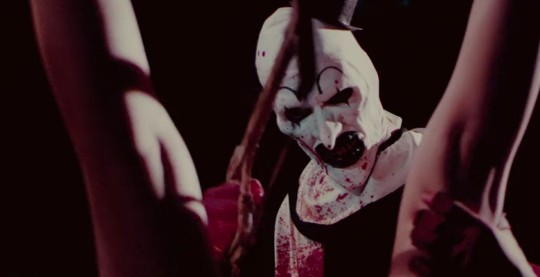
To be really, really clear, I don't think that media should be constrained to saying whatever we think is good for society in real life. I think artists have as much right to say whatever they want, as audiences have to criticize it as harshly as they like, or to simply change the channel. (I'd put a boundary on this only where we're talking about out in the open political propaganda whose obvious motivation is a call to action, but fortunately, that's not what I'm dealing with in this piece) There is no level on which I'm suggesting that filmmaker Damien Leone shouldn't be doing what he does, and in our intensely moralizing cultural moment, I hope that nothing I say about his movies is taken as a recommendation to censure him. I just find it impossible to talk about his invention of Art the Clown without addressing the extreme, misogynistic hostility that pours out of these projects. It's probably reasonable to assume that creators of this ilk stage gonzo attacks on female victims out of an affectionate nostalgia for films like MANIAC and THE TOOLBOX MURDERS that so worried second wave feminists. In the case of the TERRIFIER movies, though, one might feel like they push things past the point of homage and into what can come off as a real love of the thought of chopping up girls.
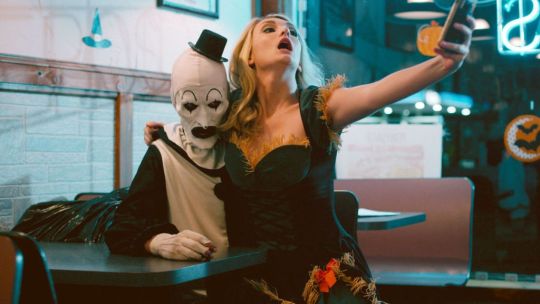
Damien Leone's 2013 anthology film ALL HALLOW'S EVE is best known as a container for his 2011 short TERRIFIER, in which a young, horror-loving costume designer is tormented by the silent, psychotic Art the Clown. In that segment, after decorating a gas station bathroom with his own excretia, Art hounds the young woman, whipping her with a scourge made out of all sorts of sharp objects, and eventually amputating her limbs and carving slurs like SLUT and CUNT all over what remains of her body. Some of these images made their way into the feature version of TERRIFIER five years later, though notably not the latter bit, which—and I know this is going to make me sound insane considering the context—is just really unnecessary. Art the Clown functions best as a chaos agent who dismantles everyone and everything in his way purely for his own amusement, so there's something off about him focusing on a hatred of attractive young women specifically. You kind of want Art to be like a slasher movie version of Bugs Bunny; when he expresses this incel obsession with women as sources of sexual frustration, it's limiting and distracting. It feels like something the movie insists on to its own detriment…and like, why?
2016's TERRIFIER may have disposed of the idea of vandalizing a woman's body with "whore"-type epithets, but it sticks with the notion of targeting attractive girls and taking away their beauty to punish them. Sure, there are a few male victims in this movie, but who could possibly remember them when the movie's centerpiece is a nude teenage girl who Art bisects with a hacksaw, beginning at her crotch? The doomed men don't quite get the same gender-specific treatment as a bag lady whose severed breasts Art parades around in, or the girl whose face Art eats, leaving her as a circus freak version of herself whose outrageous ugliness drives her insane. TERRIFIER moves so single-mindedly from one gore gag to another, without anything resembling character or plot development, that it's hard not to focus on the rather specific spectacle of violence against women and their femininity.
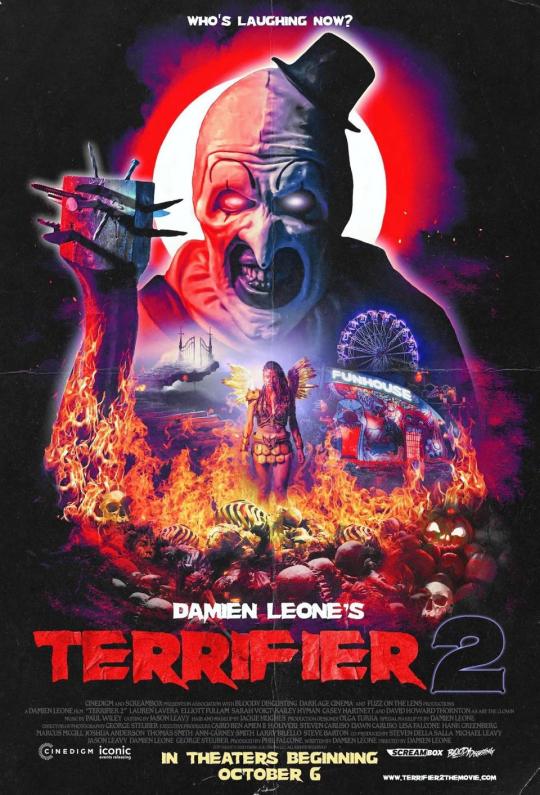
By contrast, 2022's TERRIFIER 2 is a masterpiece of dramaturgy. Sure, it takes almost two and a half hours to make its point (?!), but this movie has distinct characters, a story, and more experimentation to offer than its predecessors. Interestingly, it also represents a culmination of all of Damien Leone's creative work. All three have an opening salvo that involves a bunch of literal shit, a cat o' nine tails scene, and the idea of women losing their minds when they lose their attractiveness. TERRIFIER 2 also brings the realization of failed plans Leone had for his first short, THE 9TH CIRCLE, which was originally meant to involve an angel figure battling Art the Clown. Finally, the latest film blows up a detail from the least of the three components of ALL HALLOW'S EVE, and makes it a central piece of the puzzle: The middle section of the anthology features a woman being terrorized by an alien invader, but a stray piece of that story is that her absent husband makes disturbing paintings featuring Art. That's a loose thread in ALL HALLOW'S, but in TERRIFIER 2 it becomes the key to the protagonist's destiny. I may not love these movies, but I respect Leone's long-term focus, and it has brought him a long way from his humbler origins.
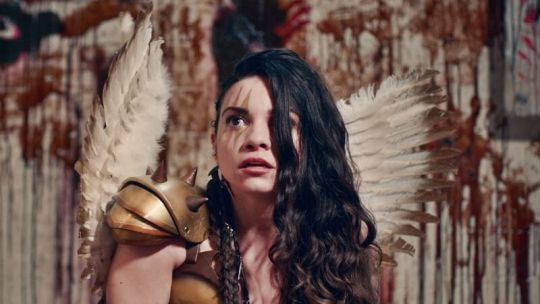
TERRIFIER 2 finds aspiring costume designer Sienna (the very appealing Laura LaVera) painstakingly assembling a She-Ra-like Halloween costume based on her late father's designs. Sienna and her little brother Jonathan (Elliott Fullam) have both inherited his interest in dark fantasy, but where Sienna channels it into productively chasing after her career goals, Jonathan is haunted by their father's visions. He pores over an old sketch book containing images suggestive of the Miles County Massacre that took place in the first TERRIFIER film, and plans to go as Art the Clown for Halloween. Sienna and their mother Barbara (Sarah Voigt) worry that Jonathan is a burgeoning psycho, but we see him as a sensitive young man who his ambivalently drawn to what frightens him—a relatable characteristic for any horror fan—and moreover, these images are all he has left of his dad, who committed suicide after a battle with brain cancer. The family speculates that their patriarch's disturbing visions resulted from his tumor, but both Sienna and Jonathan suffer similarly: while Jonathan fixates helplessly on Art, Sienna has disturbing nightmares about the clown, and is already being medicated for psychological issues. Art (David Howard Thornton who, let's face it, makes these movies), meanwhile, is having his own familial experience with a new character credited as the Little Pale Girl (Amelie McLain), a psychotic tot made in Art's image who accompanies him on his new killing spree. Only Sienna and Jonathan can see the Pale Girl, suggesting that she is the product of whatever supernatural force resurrected Art at the end of the first TERRIFIER film; furthermore, it becomes clear that Jonathan and Sienna's father was not deranged by illness, but he had actually channeled a vision of how his children could put a stop to the clown's rampage.

Whether or not this story achieves real coherence is beside the point, which I posit is about how you channel your id material. The kids' father was tormented by it unto death; Art and his daughter (?) enjoy it shamelessly; Jonathan tries to understand what scares him; Sienna makes herself into an avenging angel that can defeat it. It's an interesting meditation for a series of movies that appear to be all about pure aggression and the pleasure of stirring people up. After fifteen years of hard work, Damien Leone has refined his vision into an essay on the faces of horror fandom: Many people are happy to accuse horror fans of psychopathy, ignoring the fact that fans are often sensitive types who use the genre to safely explore difficult feelings and experiences. Sure, some of us turn into assholes, but others find paths that are creative and productive, not destructive. And this is how, after hours of sometimes-painful viewing and chewing, I have somehow found my way to finding something nice to say about the TERRIFIER series. I may not have enjoyed it, but I came to respect it (or at least, the incredible work ethic required to get it done), and I think maybe I finally get it. Still and all, I'm glad I can finally stop watching it. Onto the next!
#blogtober#blogtober 2022#terrifier#terrifier 2#all hallow's eve#anthology#horror#slasher#supernatural#killer clown#damien leone#laura lavera#elliott fullam#Amelie McLain#sarah voigt#David Howard Thornton
11 notes
·
View notes
Photo

How was the solar system formed Mineral samples collected from the Ryugu asteroid by the Japan’s Hayabusa2 spacecraft are helping UCLA space scientists and colleagues better understand the chemical composition of our solar system as it existed in its infancy, more than 4.5 billion years ago. In research recently published in Nature Astronomy, scientists using isotopic analysis discovered that carbonate minerals from the asteroid were crystallized through reactions with water, which originally accreted to the asteroid as ice in the still-forming solar system, then warmed into liquid. These carbonates, they say, formed very early on — within the first 1.8 million years of the solar system’s existence — and they preserve a record of the temperature and composition of the asteroid’s aqueous fluid as it existed at that time. The rocky, carbon-rich Ryugu is the first C-type (C stands for “carbonaceous”) asteroid from which samples have been gathered and studied, said study co-author Kevin McKeegan, a distinguished professor of Earth, planetary and space sciences at UCLA. What makes Ryugu special, he noted, is that unlike meteorites, it has not had potentially contaminating contact with Earth. By analyzing the chemical fingerprints in the samples, scientists can develop a picture of not only how Ryugu formed but where. “The Ryugu samples tell us that the asteroid and similar objects formed relatively rapidly in the outer solar system, beyond the condensation fronts of water and carbon dioxide ices, probably as small bodies,” McKeegan said. The researchers’ analysis determined that Ryugu’s carbonates formed several million years earlier than previously thought, and they indicate that Ryugu — or a progenitor asteroid from which it may have broken off — accreted as a relatively small object, probably less than 20 kilometers (12.5 miles) in diameter. This result is surprising, McKeegan said, because most models of asteroid accretion would predict assembly over longer periods, resulting in the formation of bodies at least 50 kilometers (more than 30 miles) in diameter that could better survive collisional evolution over the long history of the solar system. And while Ryugu is currently only about 1 kilometer in diameter as a result of collisions and reassembly throughout its history, it is very unlikely it was ever a large asteroid, the researchers said. They noted that any larger asteroid formed very early on in the solar system would have been heated to high temperatures by the decay of large amounts of aluminum-26, a radioactive nuclide, resulting in the melting of rock throughout the asteroid’s interior, along with chemical differentiation, such as the segregation of metal and silicate. Ryugu shows no evidence of that, and its chemical and mineralogical compositions are equivalent to those found in the most chemically primitive meteorites, the so-called CI chondrites, which are also thought to have formed in the outer solar system. McKeegan said ongoing research on the Ryugu materials will continue to open a window onto the formation of the solar system’s planets, including Earth. “Improving our understanding of volatile- and carbon-rich asteroids helps us address important questions in astrobiology — for example, the likelihood that rocky planets like can access a source of prebiotic materials,” he said. To date the carbonates in the Ryugu samples, the team extended methodology developed at UCLA for a different “short-lived” radioactive decay system involving the isotope manganese-53, which was present Ryugu. The study was co-led by Kaitlyn McCain, a UCLA doctoral student at the time of the research who now works at NASA’s Johnson Space Center in Houston, and postdoctoral researcher Nozomi Matsuda, who works in the ion microprobe laboratory of the UCLA’s Department of Earth, Planetary and Space Sciences. Other co-authors of the paper are scientists from the Phase 2 curation Kochi team in Japan, led by Motoo Ito. This team is responsible for curating particles from the regolith sample collected from the Ryugu asteroid and analyzing their petrological and chemical characteristics by coordinated microanalytical techniques. The work was funded by the Japan Aerospace Exploration Agency, NASA, the National Science Foundation’s Instrumentation and Facilities program and several agencies in Japan.
2 notes
·
View notes
Text
Cookbooks and Home Economics : Free Texts : Free Download, Borrow and Streaming : Internet Archive
The Cookbook and Home Economics Collection includes books from the Young Research Library Department of Special Collections at UCLA, The Bancroft Library at The University of California, Berkeley, and the Prelinger Library. These fascinating books take us back to an America in the early decades of the 20th century covering topics on cookery, textiles, family and home, budgeting, domestic…

View On WordPress
0 notes
Text
On Immortality
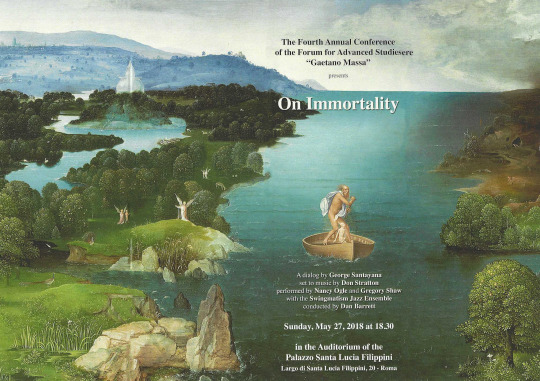
On Immortality
A Dialogue by George Santayana
Set to music by Don Stratton
Directed by Dan Barrett
with
Nancy Ellen Ogle and Gregory Shaw, narrators
and the Swingmatism Jazz Ensemble:
Jay Bregman, tenor saxophone
Dan Barrett, trombone
Colin Graebert, piano
Bob Roman, bass
Bobby Duron, drums
Notes
An ancient Greek myth about the after-life turns out to have been true. A stranger who has recently died finds herself on a raft crossing the River Styx, being ferried along with other newly departed souls to the Island of Remembrance by the god Charon.
In this modern version of the myth, Santayana engages the departed soul in conversation with the gaunt ferryman, exploring issues of life and death. In Santayana’s view, truth is simply everything that has actually happened; as such, it is impossible for anyone to live in the present and, at the same time, live in the truth. On realizing this view, the stranger becomes liberated from previous notions about living and dying and is newly able to enjoy the phenomena of existence as they arise.
Don Stratton (1928-2016) was a teacher, composer and trumpet player of national acclaim. In 1976, Don's “The Seasons in Maine” was performed by the Bangor Symphony at the Kennedy Center in Washington D.C., representing our State in the national bicentennial celebrations.
A Clark Terry protégé, Don was known as a trumpet player influenced by Bix Beiderbecke (as well as modern jazz trumpet players. Notably he blew with Phil Woods, Kenny Clarke), Elliot Lawrence and Claude Thornhill. His American Post-Forty Blues, for orchestra and solo trumpet is a perfect example of Third Stream Music.
As Professor of Music at UMaine, Don created the 20th Century Music Ensemble, in which students enthusiastically performed a wide variety of jazz along with far out experimental works and lyrical compositions. Don's music is archived in a special collection at the Bangor Public Library.
Philosopher George Santayana (1863-1952) wrote in a broad spectrum of genres. His major works include The Life of Reason (5 vols.), The Realms of Being (4 vols.) and a best-selling novel, The Last Puritan. He spent his final years living in Rome, where he wrote “On Immortality,” which was published posthumously.
Emeritus Professor of History, and member of the Board of Directors of the International Society for Neoplatonic Studies, Jay Bregman has taught at UCLA, UC Berkeley and Howard University, as well as at UMaine, where he has taught History of Jazz for over 30 years. He studied Jazz with Lennie Tristano, Yusef Lateef and Don Stratton, and played with Don. For a decade, he and Don taught an Honors Seminar on American Aesthetics and Subcultures, covering such topics as the New England Transcendentalists, Zen, Ives and Monk, Neoplatonism, the Beat Authors and Pythagorean Aesthetics. Tonight’s composition reflects that interdisciplinarity.
UMaine Professor Nancy Ellen Ogle’s work with contemporary composers is available on recordings on Capstone, Cormorant, Woodsum, New Media Productions and Parma labels. In 2014, Nancy was a Grammy nominee in the category of best classical solo vocal recording for a CD of Scott Brickman’s music featuring Ogle singing his Dear Darwin songs (Ravello Recordings). Nancy has premiered several of Don Stratton’s compositions, including A Recital of Birds and Ktaadn.
A fellow of the F.S.A., Gregory J. Shaw is Professor of Religious Studies at Stonehill College (Massachusetts, USA). His research interests include Religions of Late Antiquity, especially Neoplatonism; history of divination with an emphasis on dreams; contemporary religious movements that draw from Hermetic and Platonic sources; Jungian psychology; UFO phenomena.
Dan Barrett teaches trombone, tuba, jazz improvisation, jazz piano and arranging, and runs the jazz combo program at the University of Maine. He has been privileged to perform with many jazz greats including Bob Mintzer, Conrad Herwig, Andy Martin, John Fedchock, Thomas Gansch, Ingrid Jensen, Phil Markowitz, Eric Marienthal and Byron Stripling.
Colin Graebert has been playing jazz piano in Maine for almost twenty years. He is an active member or the Maine music scene as an accompanist, choir director, vocalist, musical theatre director and clinician. He recently graduated from the University of Maine with a Bachelor of Music in Music Education and is looking forward to officially joining the ranks of Maine’s music teachers. He lives in Stockton Springs with his wife, Hilary, and two children, Eric and Ruth.
UMaine graduate and student of Don Stratton, Bob Roman maintains an active performing schedule. In addition to this ensemble, he is also a member of the house band on “The Nite Show with Danny Cashman” and many others.
Bobby Duron has been playing drums professionally for over 40 years. Originally from Dallas, Texas, he now resides in Hampden, Maine, where he is a professor at Husson University and an active freelance musician and clinician in the greater Bangor area.

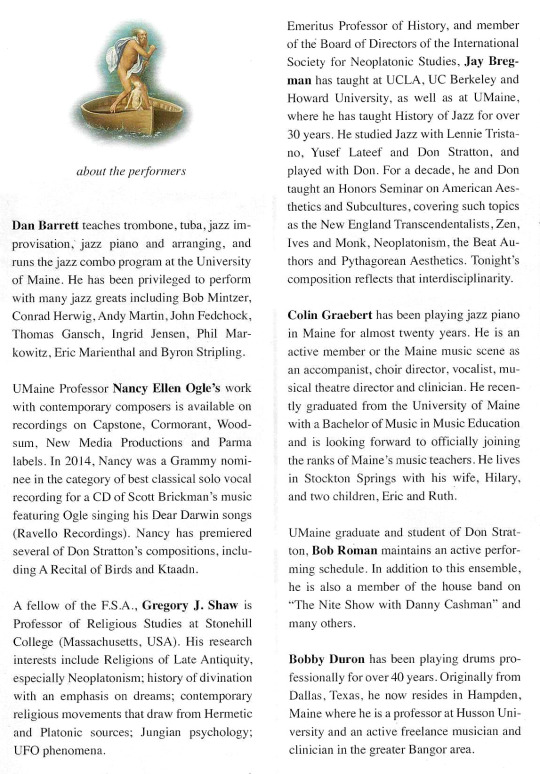
0 notes
Text
Incompetence, Neglect, or Both? Report of Social Services System Provides Insight into the Turpin Children’s Circumstances
By Maeve Morley, State University of New York at Geneseo, Class of 2022
July 11, 2022

It’s been more than two years since David and Louise Turpin were sentenced to 25 years to life in prison “for the torture, abuse and imprisonment of their children” [1]. It wasn’t until 17-year-old, Jordan Turpin escaped her family’s home in Perris in Riverside County, Calif. in 2018 and called the police, that the truth of her and her sibling’s abuse came to light [2]. The thirteen Turpin siblings, ranging in ages 2 to 29, were “starved, chained to beds and forced to live in squalor” [2]. “The children slept during the day, were active a few hours at night and had minimal education” [2].
Since their parent’s conviction, Riverside County “retained” law firm, Larson LLP led by former U.S. District Judge Stephen Larson, to conduct an investigation into “[assessing] its care of the Turpin children” and the overall performance of the county system [1]. On Friday, a report containing their findings from the eight-month long investigation was released [1].
Beginning in October 2021, Larson LLP “assembled a team of professors and researchers from UC Berkeley, UCLA and Virginia Tech to conduct an extensive review of more than 30,000 pages of county documents” [1]. Additionally, hundreds of interviews were conducted of “personnel, stakeholders, family members and staff members, among others” [1].
According to officials, “a Riverside County Board of Supervisors ad hoc committee will oversee the implementation of the report’s recommendations” [1]. Committee co-chair, Supervisor Karen Spiegel announced in a statement “As public servants, our duty is to ensure that our most vulnerable communities are receiving the care and protection they deserve. I am dedicated to making sure we have the tools, resources and staffing to provide that care” [1]. On July 12th, the report will be “publicly presented” to the Committee [2].
Although a significant portion of the report was amended for privacy purposes, it detailed various concerns over the duration of some of the children’s conservatorship, appointed by the Office of Public Guardian (OPG) in Riverside County, along with a collective range of issues within the county’s social services system [1]. A “June 24 introductory letter to supervisors that was included in the report, acknowledged “With respect to the Turpin siblings, we conclude there were many times over the last four years that they received the care they needed from the county. This was not always the case, however, and all too often the social services system failed them” [2].
Prosecutors charged a foster couple and their adult daughter with abuse after two of the Turpin sisters were “fondled and kissed by the father and other foster children were physically assaulted” [2]. “Many were caught in the middle of confusing and complicated legal proceedings” the letter stated [2]. “When they complained about their circumstances, they often felt frustrated, unheard, and stifled by the system” [2].
Furthermore, the issues found within Riverside County’s social services system, stipulated concern regarding “overworked staff, high caseloads, underfunded programs and poor coordination across departments” [1].
Aside from highlighting the issues within the county’s OPG and child services system, the report “recommended policy changes to help reform [the system], including increasing staffing and compensation for the Children’s Services Division and the Office of the Public Guardian to ensure parity with surrounding counties” [1]. In addition, “it called for setting caseload limits for field workers and for launching a countywide effort to expand the availability of high-quality and safe foster care placements for children with special needs” [2].
______________________________________________________________
Maeve Morley is a recent graduate at the State University of New York at Geneseo. She plans on attending law school in the near future.
______________________________________________________________
[1] https://www.latimes.com/california/story/2022-07-08/turpin-children-were-failed-unheard-stifled-by-california-social-services-investigation-finds
[2] https://www.usatoday.com/story/news/nation/2022/07/08/turpin-abuse-case-13-children-failed-social-services-after-rescue/10019197002/
0 notes
Text
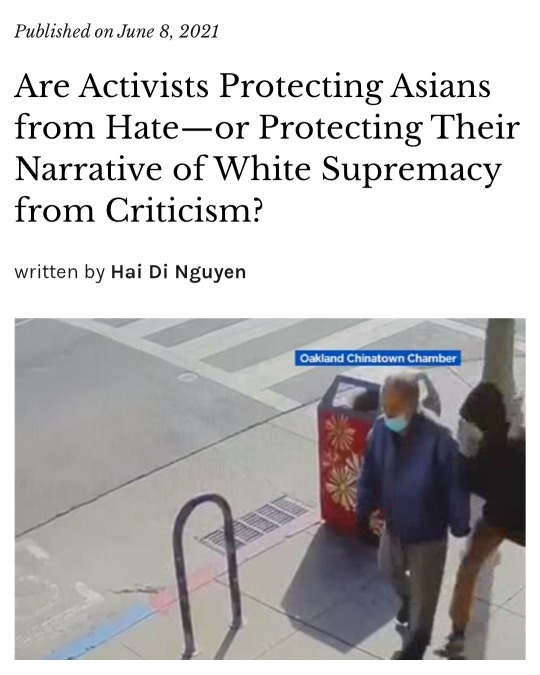
Not only is white supremacy the root cause of all anti-Asian attacks, we are told, but the very mention of black assailants serves to bolster an illusory or harmful trope. Examples here include “Stop Blaming Black People for Anti-Asian Hate” (Newsweek), “Old tropes of Black-Asian conflict rear up after NY assault” (Chicago Tribune), and “Why the trope of Black-Asian conflict in the face of anti-Asian violence dismisses solidarity” (Brookings Institution).
On #StopAsianHate, a piece titled “The ‘Black-Asian Conflict’ Is a Problematic Trope—and It’s Time to End It” informs us that any anger directed at black assailants is a mask for “White establishment anxiety.” At Mic, Melissa Pandika argues that we should refrain from posting photos of suspects in anti-Asian hate crimes—but only if those suspects are black. “Posting photos of white suspects,” on the other hand, “can help counter the narrative that the majority of anti-Asian attacks are perpetrated by Black people, and convey what the research actually finds: White people are more likely to commit anti-Asian hate crimes.”
This brings us to the issue of crime statistics. Pandika bases her claims on a University of Michigan Virulent Hate Project study of news articles that describe incidents of anti-Asian racism. “In the 4,337 news articles that we reviewed, we identified 1,023 unique incidents of anti-Asian racism that occurred in the United States between January 1 and December 31, 2020,” the authors reported. And while “only a small fraction of news articles explicitly identified the race of the individuals who harassed or discriminated against Asian and Asian American people … in the few harassment incidents for which the news media explicitly stated the race of the offender, the majority of perpetrators of anti-Asian harassment were reported to be male and white.”
On page 14 of the study, we learn that the race of offenders was explicitly identified in only 57 anti-Asian harassment incidents. Of these 57 incidents, white individuals were reported as perpetrators in 44, Blacks in six, Hispanics in four, Chinese in three, Vietnamese in one. “The information that we have,” the authors conclude, “while limited and imperfect, does not support the common claim that Black hostility is driving the current epidemic of anti-Asian racism and violence.”
There are a few problems here, however. The first is that the data isn’t comprised of actual crime statistics, but just information gleaned from news articles. And even within those news article, only a tiny minority mention the perpetrator’s race. As the authors themselves note, “reporting practices might differ by the race of the perpetrator, and it is not clear how news outlets and individual reporters chose to navigate the complex issue of racial identification in its coverage of specific incidents discussed in the articles we reviewed.”
More importantly, the University of Michigan study groups together vastly different forms of behaviour, from harassment and vandalism down to “stigmatizing and discriminatory statements, images, policies, and proposals.” Among the 184 total incidents in which race is identified, more than two thirds consist of “stigmatizing statements and actions by politicians.” And even the category of physical harassment and violence groups together getting spat at and being assaulted with deadly force.
In regard to actual hate crimes, as that term is defined by the FBI, Voice of America has reported that “only two of the 20 people arrested last year in connection with [New York City anti-Asian hate crime] attacks were white, according to New York Police Department data analyzed by the Center for the Study of Hate and Extremism. Eleven were African Americans, six were white Hispanics and one was a Black Hispanic.” According to the reporter, Masood Farivar, “most police departments do not publish this kind of data, but anecdotal evidence suggests the pattern seen in New York has emerged in other cities, as well.”
My intention here is not to perpetuate stereotypes about black people. Crime is perpetrated by individuals, not whole races. Moreover, to the extent that black people are overrepresented as assailants in this (or any other) kind of crime, it’s useful to note that crime often is linked to poverty and disadvantage, which disproportionately afflict American black communities. But that said, it is intellectually dishonest to ignore or deny the identity of real crime suspects in the service of protecting a certain kind of ideological narrative.
Even Asians themselves are being pressured to frame the attacks against them in this ideological context. UCLA lecturer Manjusha P. Kulkarni, the aforementioned co-founder of Stop AAPI Hate, has admonished Asian Americans for their anti-black and “white adjacent” attitude. “Sadly, immigrants come to the United States often and understand right away the racial hierarchy that we have in our nation,” she states in her widely circulated video. “And so they know that if they want upward mobility, they want economic security, they need to align themselves with whites, essentially. And so you see a lot of that white adjacency in our community or efforts to strive toward white adjacency.”
Such language channels the idea that, as recently described by Quillette contributor Kenny Xu, the success of Asian-Americans can be traced to their “proximity to whiteness.” Seen through this lens, even when Asian Americans feel themselves under threat of physical attack, they bear a special moral responsibility to ensure that their response is ideologically onside with the fight against white supremacy.
What does this mean in practice? According to journalist Kayla Hui, this means that Asians must resist endorsing the most obvious source of relief from street crime: the police. “Policing only catalyzes racial tensions between Asian and Black communities,” Hui writes. By way of alternative, Hui urges “bystander and de-escalation training to learn how to intervene when anti-Asian hate and harassment occurs.” And in the long run, “Asian solidarity with Black and brown communities [would serve as] a catalyst for tackling white supremacy and the systems that continuously uphold and enable racism.”
Cat Brooks, co-founder of the Anti-Police Terror Project, a black-led organisation based in Oakland, says that instead of funding increased policing as a means to prevent anti-Asian violence, money should go toward “groups that are doing this work anyway,” such as local community patrols. And in an NBC News article “Critics fear NYPD Asian hate crime task force could have unintended consequences,” reporter Kimmy Yam leads with the statement that “The New York Police Department’s new anti-Asian hate crimes task force could inadvertently put Asian Americans in opposition to other communities of color, some activists fear.”
In response to the recent spate of anti-Asian attacks, the US government has enacted the COVID-19 Hate Crimes Act, which promotes the reporting of hate crimes at local and state levels. One might think that Asian groups would welcome the move. Yet a coalition of over 100 Asian and LGBTQ organisations have opposed the law, on the basis that the mere collection and reporting of hate-crime data “contradicts Asian solidarity with Black, Brown, undocumented, trans, low-income, sex worker, and other marginalized communities whose liberation is bound together.” The idea here is that police should be removed from “communities and neighborhoods” altogether; and that the security of the population should instead rest on such “community alternatives” as “non-coercive mental healthcare infrastructures, neighborhood-based trauma centers [and] community food banks.”
The signatories believe that collecting crime statistics and empowering the police more generally fails to address “the structural conditions that lead to violence against marginalized communities.” Obviously, they are free to argue for such a wholesale reorientation of American public policy (even if it flies in the face of recent evidence). But it is disingenuous to pretend that they are doing so in the service of protecting Asian people from physical attacks, or protecting the interests of Asians more generally. From first to last, this manifesto reads as a defence of a certain ideological stance. And to the extent that Asians are treated as autonomous political actors, it is on the expectation that they will play their assigned role in expressing “solidarity” with other groups.
Indeed, one wonders what the true goal is here. Advocates will tell you that their fight against white supremacy is a means to protect hate-crime victims. But often it seems that means and end have become reversed, and that these crimes now serve as a prop in the larger ideological campaign against our supposedly white-supremacy-saturated culture—a campaign that Asians themselves are now being pressured to join. Whatever you may think of this ideology, it seems doubtful that its champions are motivated primarily by the need to protect Asians from violence.
3 notes
·
View notes
Photo
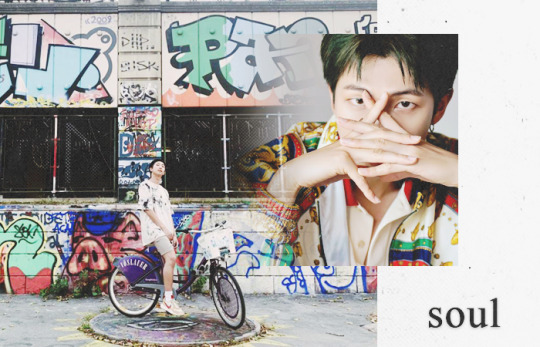
── ❝ 001 : CHARACTER STUDY: SUNWOO SEONG ❞ ───
Name: Sunwoo “Sean” Seong
Age: 26
Gender: Nonbinary Male
Pronouns: He / him + They / them
Birthday: Saturday, January 01st 1994 at 06:59 AM
Zodiac sign: Capricorn
Enneagram Type: Type 8 — THE CHALLENGER
Character Alignment: Chaotic Good
Myers-Briggs Type: ENTJ-A
Chinese Zodiac Sign: Rooster
Birthplace: Santa Monica, California ( Pico District )
Ethnicity: Korean American
Current Location: Downtown Santa Monica
Occupation: Reference Librarian / Anonymous Street Artist
Sexual Orientation: Pansexual + Demisexual
Relationship Status: Single
Nicknames / Aliases:
— “Sol” ( artist tag / alias )
— “Sean” ( acquaintances / generally )
— “Sunny” ( close friends & family )
── ❝ HEADCANON COUNTDOWN ❞ ───
5. FIVE HEADCANONS ABOUT:
Mental Health.
O1. While Sunwoo doesn’t have any psychological disorders that are massively disruptive to their lifestyle, they do exhibit signs of mild narcissism and characteristics of OCD.
Sexual Orientation.
O2. Sunwoo identifies as pansexual and demisexual. They feel sexual attraction once they have a close emotional bond with someone, and that someone can be anyone regardless of gender.
Their Appearance.
O3. Their appearance is one of the things they take the most care and pride in. They don’t make a large effort to look flashy, but they like to have an unique flare to their style no matter where they’re going. For work they make ‘business-casual’ attire look formal. For casual gatherings, it might be comfortable but it also looks ridiculously coordinated and cool. They’ve picked up their tricks from looking through countless fashion mags while cataloguing at the library but fashion is a general interest of theirs. Especially since California is a lively state with an infinite pace of styles.
History of their name.
O4. It is one of the Seong family traditions that the parents pick the name of their firstborn grandchild, so Sunwoo’s grandparents chose their name as they’re his mother’s firstborn. Sunwoo’s grandparents chose the name because it sounded mighty and powerful for a boy. But the tradition is also why Sunwoo cracks jokes about how their little brother gets away with getting a generalized name. Sean is the name they chose to generally introduce themselves to people as.
O5. As for their tag name “Sol”, Sunwoo adopted the name during their time doing community service when serving as a volunteer at the library. They became obsessed with mythology and studying the different types of it. The name Sol was always associated with the sun, much like their own name was. On top of that, they embrace the name even more because of its interchange of pronunciation between the word “soul” ( which they feel all art speaks from + calling themselves the ‘soul’ of Pico ) and Seoul, the capital of South Korea, and a homage to their roots.
4. FOUR HEADCANONS ABOUT:
Academics.
O1. After graduating high school, Sunwoo jumps in to study at UCLA. At the age of 20 after interning at Los Angeles County Museum of Art, they complete their two year program and receive their master’s degree in Library and Information Science (MLIS) with special concentrations in academics, reference, and user services.
Favorite Things.
Three things Sunwoo cannot function too far without:
O2. Diet Coca Cola ( they’re always seen with one. It’s a pretty unhealthy habit they’re busy trying to break. )
O3. a nice watch ( they love having matching watches to go with their outfits )
O4. and a fidget spinner. ( Sunwoo enjoys spinning them when he’s idle at work or in deep thought. They can do a few tricks. Their little brother turned them onto these after leaving a few at his apartment by accident. )
3. THREE HEADCANONS ABOUT:
Languages spoken.
O1. Sunwoo can speak in English, Korean, and Spanish fluently. They started to pick up Spanish from friends as a teen and chose to completely commit to learning the language when they noticed a need for speakers during their time doing community service work at the library. Between learning Mandarin and Spanish, both predominant languages in the community, Sunwoo opt for Spanish not only for the need but also? They quietly enjoy the shock of people have when an Asian begins fluently speaks the language.
Home life.
O2. Sunwoo was raised in a single-parent home, since their dad walked out on their family when they turned 17. He went off to marry another woman and began a family of his own and Sunwoo resents him for it. Otherwise, Sunwoo’s mom and his baby brother, Mason are their world and he would do anything for them. He was quick to readjust his more reckless behavior to be a better role model for Mason after their dad left. He moved out from their home in the Pico District to an apartment Downtown when they were 21.
Ethnicity/Culture.
O3. Though they were born in America they’re not shy in embracing their Korean heritage and roots. They’re very proud and appreciative of their culture and though Mason doesn’t appreciate it as deeply as Sunwoo does, they’re glad that their mother didn’t shy away from sharing and raising her boys around it despite it being in a different country.
2. TWO HEADCANONS ABOUT:
Favorite Food.
O2. Sunwoo loves loves loves pizza. If pizza is mentioned you could make them budge on close to anything. There are so many types of pizza and pizza combinations in the world you can never ever get bored.
Their Workplace.
O1. The library is their home away from home. They’ve been working at the Main Branch in the head reference librarian in the reference department for five years. Their desk and workspace is very neat. They have a two art prints and photos of them and their family framed around their desk. There’s also a small personal collection of their favorite philosophy books on display, a small desk plant, and a glass dragon egg for display simply for the aesthetic. They make sure their desk always remains neat and clean.
1. ONE HEADCANON ABOUT:
Defining moment + A Goal.
O1. It was a impromptu, spur of the moment visit back to the neighborhoods of Pico one day. They were pretty upset over something, and if you asked Sunwoo now, they still couldn’t tell you what it was exactly. All they knew was the only way to make themselves feel better was the comfort food served in a local corner store they used to frequent so often as a kid. It was a hotspot among many in the neighborhood and the family that ran it was always friendly and there was no way you could be mad once interacting with them.
Except when Sunwoo arrived, the corner store was shut down and instead had an obnoxious sign nailed outside the building about a reconstruction for a new shopping center instead. Sunwoo was baffled, wondering how many people knew, knowing the closure had to be fresh because there were a handful of people in their contacts that would’ve told them of any premeditated closures. They wondered if the family had much of a warning, as Sunwoo knew for years the business was how they made their living. The entire situation ignited a blazing fire with them. The projects of building around Pico wasn’t new per say, but this was too close to home. For a shopping center? For who’s benefit? It hit too close to home. It was too close to someone else’s home.
After days of digging, reconstructing the story on the closure, hearing more stories of displacement, and reading into the million dollar projects that would be appearing in the area of Pico over the next few years, Sunwoo’s kindled anger had become an entire firestorm.
Those they said they did, the city didn’t really care. The “betterment” of the district was at the expense of the people who lived there their entire lives. Sunwoo was one of those people. No matter how far they moved, Pico was always home.
Despite being better in the eyes of the law, serving the community to dismiss older incidents of graffiti tagging as a teen, Sunwoo picked up some old spray cans. They came back to the corner store, now sad and deserted, and went at the sign that showcased the pristine future shopping center: ‘F*CK YOU’.
It was aggressive, it was all rage, it was relieving. But it could be better. They could be better. It was start of a war, but not the one Sunwoo could see themselves continuing. Their noise couldn’t be bleak and dark like most taggers resorted to. It had to be bright. It had to paint the town, it had to speak loud and illuminate Pico to prove to Santa Monica it was something worth saving.
Pico had to have a light. And Sol would be the one to do it.
#sm:task#sm:talk#//i smashed two into one and hm lets say this unintentionally got Long™ 😰😰 pls forgive if you read thru#( sunnygraphics )
9 notes
·
View notes
Text
Burning Bridges
Pairing: Richie Tozier & Eddie Kaspbrak
Read on AO3
An excerpt from this work:
“Go back to sleep Rich. I’ll be back, I promise.” Eddie stumbles backwards and slips out the window. Soon the room settles into a lull like Eddie was never there to begin with.
The clock reads 3:35 am. Richie stays in his bed debating if he should get up and chase after Eddie but his consciousness makes the decision for him as he begins to fade into his dreams once again. Sleep overtakes him, thoughts of Eddie still swaying at the edge of his mind. Richie decides to talk to him in the morning. He will realize later that this was the worst decision of his life.Eddie
Kaspbrak was never seen in Derry again.
Summary: Richie is living the lonely life of a C-list comedian in LA until he suddenly is contacted by Mike Hanlon. 15 years after his disappearance Mike believes to have received a phone call from Eddie. The remaining Loser's return to Derry in search of answers and their missing friend.
It had been a normal day for Richie Tozier. But that’s how all tragedy’s started, with normal days.
All seven members of the Losers Club sat along the bank of the quarry. The haze of a summer heat settling along the exposed edges of their skin. Beverly was skipping rocks along the water, trying to beat her record of 6 skips. Ben watched her like she was competing in an Olympic sport, the flick of her wrist catching his gaze. Bill, Mike, and Stan sat not far off, discussing amongst themselves.
Richie had taken to climbing up a nearby tree and hanging off one of the branches by the crook of his knees. While Eddie stood underneath him rattling off the possible injuries he could get by falling.
Richie was desperately trying to keep his glasses from sliding off his face as Eddie glared at him. “I’m not going to help you if you fall and bust your head open.”
“Aw would you still love me if I got brain damage Eds?” Richie grinned swinging carelessly back and forth.
“Don’t call me Eds. And you already have brain damage asshole.” Eddie huffed, crossing his arms across his chest.
“And you still love me! How sweet,” He threw Eddie a wink. Richie thought he saw a hint of red creep around Eddie’s cheeks but wasn’t sure if that was just his own blood rushing to his head.
“That’s why we’re your friend, can’t let the poor kid with brain damage play by himself.” Stan called over, not even bothering to turn towards Richie.
“You wound me Staniel.” There was a grunt as Richie heaved himself up and began his decent down the tree. About a foot away from the ground he lost his grip and fell landing on his back with a small thud. He barked out laughter as Eddie ran to his side to make sure his skull hadn’t broken like an egg shell.
“B-by the way, what electives did everyone ch-chose for the semester?” Bill said fully ignoring the commotion taking place beside him.
A chorus of answers rang around the group, from Bev shouting home economics to Ben quietly mentioning a poetry class. Stan said photography and Richie remarked that his teacher would get tired of every picture being a bird. Eddie sat quietly in his spot beside Richie.
“What about you Eddie?” Mike smiled over at Eddie. He had also stayed silent during the discussion, there wasn’t much to say about electives when you were home schooled.
Eddie fidgeted from where he was sitting on the ground. “Ok I’ll tell you guys but you have to promise not to mention it around my mom she’ll flip.” There was a collective nod, “I uh decided to go for track and field.”
“That’s fantastic Eddie!” Bev said.
“You’ll do g-g-gr-ugh.” Bill closed his eyes in frustration before starting again. “You’ll do awesome, you have always been the fastest of us anyway.” Bill smiled along with the rest of the group. He was right, Eddie had always been the fastest of the Losers club even when he thought his asthma was real.
“Fast on the track and in the sack that’s what they say right?” Richie laughed as he was shoved by Eddie but he didn’t miss the distinct dimpled smile.
After finding out his mother had been lying to him for years about his asthma, as well as several other illnesses, Eddie had abandoned most of his placebos. Only when his mother was watching did he seem to keep up his act, not yet wanting to confront her. Richie felt a certain kind of pride bloom in his chest. The kind that had always been there but seemed to grow with each act Eddie did. Sonia was controlling and every step that Eddie took seemed to defy the tight grip she had on him. They were coming closer to the end of their high school days and Richie was excited for the future. A future he hoped contained a great deal of Eddie.
Richie knew the way he felt about Eddie differed greatly from his feelings towards the other loser’s. He didn’t stay up late at night thinking about the curve of Beverly’s legs nor did he leave lingering touches along Stan’s arms, those were exclusive to Eddie. Calling it love would make it too real. He called it a crush because crushes were soft fleeting things. Crushes were easy to get over you could skip from one to the next. Love was a hard rock that sat at the bottom of your stomach. Yet Richie could barely contain the tightening of his chest with the way each freckle stretched over Eddie’s cheeks as he smiled. Just a crush Richie reminded himself.
The losers club continued their carefree summer day at the clubhouse, reveling in one another’s company. Richie felt at peace among his friends, he wondered if this is how all his friendships would be or if this was something special.
By the time four o’clock had rolled around it had become Richie’s favorite kind of day, one where after spending time with all the losers Richie was able to squeeze in an hour or two of alone time with Eddie. After departing from the clubhouse the duo arrived at Richie’s home, eventually landing on his bed to read comics and bicker over trivial topics.
It was Eddie who brought up the subject of college, “Are you still planning on going to UCLA?” The question threw Richie off guard, especially since they just finished a heated argument over who was the better superhero, Captain America or Iron Man. But now Eddie sat on the floor of Richie’s room, his back against the bed and staring at the posters on the wall. His eyes seemed like they were searching for an answer in the Rush poster hung up haphazardly above Richie’s desk, a fruitless effort.
“Well yeah, its step one in my plan on becoming a famous comedian,” Richie turned to Eddie from where he sat on his bed. His eyes were still trained on the poster but Richie caught a glimpse of some unnamed emotion flash across them. “You should come with. UCLA has like a million majors to choose from.” Richie tried to say it as casually as possible and not like he would trade his left arm just to have Eddie in the same state as him. This was not the first time he had brought it up but he still felt the same nervousness tug at his stomach, like it was an encoded proposal.
“Like my mom would ever agree to me moving across the country with Richie Tozier.” Eddie finally returned Richie’s gaze, a somber smile on his face.
“You’re right. You’re mom would get too jealous.” Eddie groaned “Do you think I could get Mrs.K to come with me to UCLA? I’m not sure she could survive till winter break without me.” Eddie took the comic book in his lap and rolled it up before smacking Richie on the head with it. Richie laughed, a shit-eating grin spread wide across his face. Eddie wavered in his scowling, eventually laughing along with Richie. Soon both boys settled back down into a comfortable silence as they read their comic books.
As the evening sun slipped into his room it basked Eddie in an otherworldly glow, Richie wanted to burn the image into his brain. He wanted to record Eddie as he was now and replay the scene over in his head until that’s all he could see. He was almost grateful when Eddie said he needed to leave, the tips of his fingers burned with the urge to touch. But Richie smiled and pushed those feelings away, a practice he had grown accustomed to.
Richie walked Eddie to his porch, leaning on the railing as Eddie began to walk down the steps. “When will I see you again Eddie my love?”
“Jesus can you just say my name normally for once?”
“For you? No way in hell Spaghetti man.” Richie was grinning, a common occurrence when he was with Eddie. And Eddie would huff and roll his eyes at Richie’s antics but there was always a smile that followed and Richie would always chase it.
“Well Bill wants us all to meet up at his house tomorrow, his aunt sent him a board game and it can play up to ten people so now we won’t have to fight over who goes first.” Eddie said, hopping off the last step of the porch and turning to face Richie.
“Then I guess I’ll see you tomorrow when I show you my awe-inspiring board game skills.” Richie wore a cocky smile, it always gave him a special rush knowing exactly what buttons to push to rile Eddie up.
“Oh shut up you couldn’t even beat me at Clue.” Eddie crossed his arms, face already formed into a pout.
“Hey that’s not fair, you know I suck at those murder mystery games!”
“Well it’s a mystery why I’m still friends with you” Eddie smirked as Richie let out a dramatic gasp, clutching his chest as if Eddie had shot him on the spot.
As he turned to leave down the driveway Richie shouted “see you tomorrow!” Eddie turned around briefly to wave at Richie before scurrying off towards his own house and out of Richie’s sight.
After dinner Richie went to bed peacefully, happy with how the day went. That was before he was awoken at 3:21 am.
Richie was a heavy sleeper, he had always been since a young child. That night he did not hear a window creaking open or shoes shuffling on carpet, he wasn’t awake until a gentle hand began to stroke his hair. Even then Richie was still dancing between sleep and consciousness. He shifted, opening his eyes just barely only to close them again then repeating the process a few more times before comprehending that for a hand to touch his head it needed to be attached to a person that was presumably in his room. His eyes opened fully to see a dark figure standing over him.
Shock would have set quickly into his veins if not for the hand still combing its way through his hair, daring him to sleep once again. He made a sound that was a mix between a grunt and a slurred “what”. The hand retracted as Richie grabbed his glasses off his night stand. While the figure was less blurry they were still just as dark and only after his eyes adjusted did Richie catch the face of the intruder. The sliver of moonlight peaking from behind the clouds illuminating just enough for recognition to kick in.
“Eddie?” Richie questioned, head feeling like it was stuffed with cotton.
Eddie jerked back slightly, his face still mostly shadows. Richie was having a hard time making the connections his brain needed to make. “Richie” Eddie said finally and if Richie were more lucid maybe he would have caught the distinct wetness Eddie’s voice carried. “I’m sorry I didn’t mean to wake you.”
Richie rubbed his eyes, “What are you doing here man?” He went to turn on his lamp but Eddie grabbed his wrist.
“No don’t.” Richie was taken aback “Sorry its just…“ There was hesitation in his voice and Richie started to wonder if this was a dream, it felt too weird to be reality. “I needed to see you.” There is another pause as Eddie let go of Richie’s wrist before kneeling down beside the bed. Richie felt the warmth of a hand on his cheek. “Richie I need you to listen carefully. I’m going to be gone for…“ he breathed in sharply “I- I’m not sure how long. But I promise you I will be back ok?”
“Eddie you’re not making any sense” Richie’s voice dripped with confusion as his gut started to tug at itself. This wasn’t the Eddie that Richie knew, this wasn’t the spitfire that always spoke his mind and was trustworthy to a fault. No this Eddie sounded uncertain and scared.
“I know, I’m sorry” Richie thinks he hears a sniffle, “I can’t….just remember I’ll be back Richie, please remember that.” Eddie leans forward and rests his head on Richie’s shoulder as he begins to shake.
Richie wraps his arms around Eddie, softly running his hand down his back. They stay like that for a moment and Richie starts to wonder again if this is an elaborate dream.
Eddie pulls back, “Richie I-“ he says it like something important is dancing on the tip of his tongue ready to dive, but he just shakes his head “I have to go” he slips away before Richie can protest. “Go back to sleep Rich. I’ll be back, I promise.” Eddie stumbles backwards and slips out the window. Soon the room settles into a lull like Eddie was never there to begin with.
The clock reads 3:35 am. Richie stays in his bed debating if he should get up and chase after Eddie but his consciousness makes the decision for him as he begins to fade into his dreams once again. Sleep overtakes him, thoughts of Eddie still swaying at the edge of his mind. Richie decides to talk to him in the morning. He will realize later that this was the worst decision of his life.
Eddie Kaspbrak was never seen in Derry again.
Thank you for reading! If you are interested please check out my AO3 as I probably won’t post anymore chapters on Tumblr. Feel free to leave comments and constructive criticism!
#reddie#richie tozier#eddie kaspbrak#it#it chapter 2#fanfic#my art#it movie#losers club#bill denbrough#beverly marsh#stan uris#mike hanlon#ben hanscom#writing
13 notes
·
View notes
Photo

Fire in the Library - The 1986 Los Angeles Central Library fire
It was the largest library fire in the history of the United States. 400,000 books were destroyed and over 700,000 were damaged by water or smoke. It took firefighters over seven hours to put out the fire with little flare ups continuing for several days.
Here are some images of the fire gleaned from the digital collections of the UCLA library. They are all from the the Los Angeles Times Photographic Archive. Department of Special Collections, Charles E. Young Research Library.

The epic blaze was the basis of Susan Orlean’s 2018 bestselling and New York Times Notable Book of the year, The Library Book.

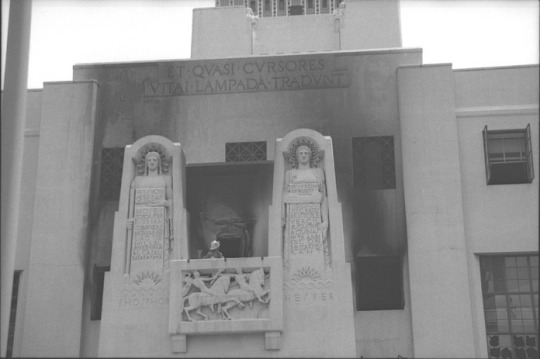

#los angeles#libraries#fire#arson#books#firefighter#library book#special collections#ucla#archives#los angeles times#bookpatrol
13 notes
·
View notes
Photo

“Star of the Sea,” Los Angeles Daily News, January 1, 1938
#rose parade#1930s#1930s fashion#vintage#old los angeles#vintage fashion#parade float#tournament of roses#los angeles#los angeles daily news#photojournalism#strange#creepy#black and white#photography#photo edit#ucla department of special collections#21198/zz0025gr23
517 notes
·
View notes
Text
Einstein's general relativity theory is questioned but still stands for now
More than 100 years after Albert Einstein published his iconic theory of general relativity, it is beginning to fray at the edges, said Andrea Ghez, UCLA professor of physics and astronomy. Now, in the most comprehensive test of general relativity near the monstrous black hole at the center of our galaxy, Ghez and her research team report July 25 in the journal Science that Einstein's theory of general relativity holds up.

"Einstein's right, at least for now," said Ghez, a co-lead author of the research. "We can absolutely rule out Newton's law of gravity. Our observations are consistent with Einstein's theory of general relativity. However, his theory is definitely showing vulnerability. It cannot fully explain gravity inside a black hole, and at some point we will need to move beyond Einstein's theory to a more comprehensive theory of gravity that explains what a black hole is."
Einstein's 1915 theory of general relativity holds that what we perceive as the force of gravity arises from the curvature of space and time. The scientist proposed that objects such as the sun and the Earth change this geometry. Einstein's theory is the best description of how gravity works, said Ghez, whose UCLA-led team of astronomers has made direct measurements of the phenomenon near a supermassive black hole -- research Ghez describes as "extreme astrophysics."
The laws of physics, including gravity, should be valid everywhere in the universe, said Ghez, who added that her research team is one of only two groups in the world to watch a star known as S0-2 make a complete orbit in three dimensions around the supermassive black hole at the center of the Milky Way. The full orbit takes 16 years, and the black hole's mass is about four million times that of the sun.
The researchers say their work is the most detailed study ever conducted into the supermassive black hole and Einstein's theory of general relativity.
The key data in the research were spectra that Ghez's team analyzed this April, May and September as her "favorite star" made its closest approach to the enormous black hole. Spectra, which Ghez described as the "rainbow of light" from stars, show the intensity of light and offer important information about the star from which the light travels. Spectra also show the composition of the star. These data were combined with measurements Ghez and her team have made over the last 24 years.
Spectra -- collected at the W.M. Keck Observatory in Hawaii using a spectrograph built at UCLA by a team led by colleague James Larkin -- provide the third dimension, revealing the star's motion at a level of precision not previously attained. (Images of the star the researchers took at the Keck Observatory provide the two other dimensions.) Larkin's instrument takes light from a star and disperses it, similar to the way raindrops disperse light from the sun to create a rainbow, Ghez said.
"What's so special about S0-2 is we have its complete orbit in three dimensions," said Ghez, who holds the Lauren B. Leichtman and Arthur E. Levine Chair in Astrophysics. "That's what gives us the entry ticket into the tests of general relativity. We asked how gravity behaves near a supermassive black hole and whether Einstein's theory is telling us the full story. Seeing stars go through their complete orbit provides the first opportunity to test fundamental physics using the motions of these stars."
Ghez's research team was able to see the co-mingling of space and time near the supermassive black hole. "In Newton's version of gravity, space and time are separate, and do not co-mingle; under Einstein, they get completely co-mingled near a black hole," she said.
"Making a measurement of such fundamental importance has required years of patient observing, enabled by state-of-the-art technology," said Richard Green, director of the National Science Foundation's division of astronomical sciences. For more than two decades, the division has supported Ghez, along with several of the technical elements critical to the research team's discovery. "Through their rigorous efforts, Ghez and her collaborators have produced a high-significance validation of Einstein's idea about strong gravity."
Keck Observatory Director Hilton Lewis called Ghez "one of our most passionate and tenacious Keck users." "Her latest groundbreaking research," he said, "is the culmination of unwavering commitment over the past two decades to unlock the mysteries of the supermassive black hole at the center of our Milky Way galaxy."
The researchers studied photons -- particles of light -- as they traveled from S0-2 to Earth. S0-2 moves around the black hole at blistering speeds of more than 16 million miles per hour at its closest approach. Einstein had reported that in this region close to the black hole, photons have to do extra work. Their wavelength as they leave the star depends not only on how fast the star is moving, but also on how much energy the photons expend to escape the black hole's powerful gravitational field. Near a black hole, gravity is much stronger than on Earth.
Ghez was given the opportunity to present partial data last summer, but chose not to so that her team could thoroughly analyze the data first. "We're learning how gravity works. It's one of four fundamental forces and the one we have tested the least," she said. "There are many regions where we just haven't asked, how does gravity work here? It's easy to be overconfident and there are many ways to misinterpret the data, many ways that small errors can accumulate into significant mistakes, which is why we did not rush our analysis."
Ghez, a 2008 recipient of the MacArthur "Genius" Fellowship, studies more than 3,000 stars that orbit the supermassive black hole. Hundreds of them are young, she said, in a region where astronomers did not expect to see them.
It takes 26,000 years for the photons from S0-2 to reach Earth. "We're so excited, and have been preparing for years to make these measurements," said Ghez, who directs the UCLA Galactic Center Group. "For us, it's visceral, it's now -- but it actually happened 26,000 years ago!"
This is the first of many tests of general relativity Ghez's research team will conduct on stars near the supermassive black hole. Among the stars that most interest her is S0-102, which has the shortest orbit, taking 11 1/2 years to complete a full orbit around the black hole. Most of the stars Ghez studies have orbits of much longer than a human lifespan.
Ghez's team took measurements about every four nights during crucial periods in 2018 using the Keck Observatory -- which sits atop Hawaii's dormant Mauna Kea volcano and houses one of the world's largest and premier optical and infrared telescopes. Measurements are also taken with an optical-infrared telescope at Gemini Observatory and Subaru Telescope, also in Hawaii. She and her team have used these telescopes both on site in Hawaii and remotely from an observation room in UCLA's department of physics and astronomy.
Black holes have such high density that nothing can escape their gravitational pull, not even light. (They cannot be seen directly, but their influence on nearby stars is visible and provides a signature. Once something crosses the "event horizon" of a black hole, it will not be able to escape. However, the star S0-2 is still rather far from the event horizon, even at its closest approach, so its photons do not get pulled in.)
Ghez's co-authors include Tuan Do, lead author of the Sciencepaper, a UCLA research scientist and deputy director of the UCLA Galactic Center Group; Aurelien Hees, a former UCLA postdoctoral scholar, now a researcher at the Paris Observatory; Mark Morris, UCLA professor of physics and astronomy; Eric Becklin, UCLA professor emeritus of physics and astronomy; Smadar Naoz, UCLA assistant professor of physics and astronomy; Jessica Lu, a former UCLA graduate student who is now a UC Berkeley assistant professor of astronomy; UCLA graduate student Devin Chu; Greg Martinez, UCLA project scientist; Shoko Sakai, a UCLA research scientist; Shogo Nishiyama, associate professor with Japan's Miyagi University of Education; and Rainer Schoedel, a researcher with Spain's Instituto de Astrofsica de Andalucia.
The National Science Foundation has funded Ghez's research for the last 25 years. More recently, her research has also been supported by the W.M. Keck Foundation, the Gordon and Betty Moore Foundation and the Heising-Simons Foundation.
93 notes
·
View notes
Text
James Bassler, Thread by Thread
This object is currently on view in Nature by Design: Cochineal.
Paired sets of stepped blocks in harmony and balance echo an ancient process. James Bassler (American, b. 1933), in his work Six by Four II, incorporates an aesthetic of pure color through the interlacing of warps and wefts in a special way. By changing the colors of each block, linked one to the other, thread by thread, Bassler follows the concept if not the technique, of the pre-Columbian weavers of Peru, who managed to achieve extraordinary heights of artistic prowess as early as the 3rd century B.C. Respecting the knowledge and skills of these weavers, Bassler engages in his own methodology, for his own time and in his own place. The geometric dualities evoke a minimalism sensitive to the modern world: but in a world where process and integrity of making, compounds the weight and meaning of the statement.
Bassler is a California-based artist who has built his career around the art and craft of weaving: he is well known and beloved in circles of the art-world that embrace this interface. Bassler graduated from UCLA with an MA in Art in 1968, and returned to teach in the Art Department, eventually as Chair, for twenty-five years, from 1975-2000. Early in his development, during the 1950s, inspired in part by Somerset Maugham’s The Razor’s Edge, Jim traveled by freighter from London to India and from there to Indonesia and Japan, where he was greatly taken by the enveloping world of textiles that permeated these cultures. Immersed and enriched by the broad array of fibers, textures and colors, he became acutely aware of the nuanced variety of materials and specialized dyeing techniques that would become a critical part of his art and process. His subsequent study of the textile traditions of Latin America also became particularly important, and from the 1960s through the 1990s, he and his wife, a ceramist, lived part of each year in Oaxaca, Mexico, where he drew from experience of the rich traditions of the region. Wanting to understand the complexities of various weaving processes, he also focused on ancient textile techniques from Peru through the study of museum collections, especially that of the Brooklyn Museum, whose collection includes some of the most astonishing examples of the method from pre-Columbian Peru.
As a weaver, Jim excels in the painstaking process of thread by thread constructions, drawing on ancient methods intersected by modern conveniences. A number of his works are constructed in the highly specialized pre-Columbian Peruvian structure using discontinuous warps and wefts—where each colored element is used only where needed, but with each color section composed of the same color in horizontal and vertical interlacing—a type of weaving done in no other region of the world.
Elena Phipps is a lecturer in the Department of World Arts and Culture at UCLA and Senior Museum Scholar at The Metropolitan Museum of Art.
from Cooper Hewitt, Smithsonian Design Museum https://ift.tt/2CVlDLK
via IFTTT
5 notes
·
View notes
Note
Hello! Pass the happy! When you get this, reply with 5 things that make you happy and send this to the last 10 people in your notifications! ☺️
#1 - Telling bad jokes and making @all-the-w-ness scream my name!!!! See, the problem isn’t that the jokes are bad ... the problem is that she laughs at them and she hates that she laughs at them which just encourages me to tell worse ones!!!!!
Two from today: The UCLA gymnastics leotards have SP on the back and she asked me what that stood for. I didn’t have a clue, but instead of saying that, I told her that it stood for Salerie Pondos. She ended up googling the name, even though she’s a huge gymnastics fan and was literally sitting right next to the court that says Valerie Kondos-Field Court. lol When she realized the bad joke she texted me back and said MICHAEL I freaking hate you. You are so evil. You are so baaaaad.I replied back lololol that’s not the life lesson that Salerie Pondos taught us!Yeah... That was fun :) (it’s actually Sylvia P. the company that makes the leotards). The 2nd one was when she was talking about where to sit, I said just go sit on the beam. If anyone asks you to move, just cough and say your chinese. I got a Lol Mike!! for that one :)
Our new running gag is in reference to the measles outbreak we had before when they quarantined students on campus and the current novel coronavirus spreading out of Wuhan and affecting a large portion of our study abroad and international student community.... We’re no longer UCLA (You see lots of asians) We’re now UCL - Q!!! (You see lots of QUARANTINE!) 2) Cats. cats always make me happy. Especially my Mystic. I still think of him every day and miss him so much. It feels like it was just a week ago that he was laying in my arms and I was holding him, and snuggling him and rocking him in my chair while he napped in my arms. I know someday soon another furball will come into my life :) Also pics of your cats. Those make me happy :)
3) Books. There’s something special about reading that nothing else matches. I love reading about other peoples experiences, what they went through, and how they made their decisions that is just so special. When you read a biography, when you read a good fiction book, when a story captures you, when you can’t turn the pages fast enough... ugh... books are awesome.
4) Getting stuff out of my box.... I have had a large box of collectibles that I’m finally getting stuff OUT of and I can see and display thanks to W :) It makes me happy to finally see the stuff and remember the places and times and joys that all of those things remind me of. They’re stickers of stations I worked, patches of departments I was with, and UCLA buttons.... pins and things like that. 5) Watching the Rookie with W... we both really enjoy it but more than anything we really enjoy watching it together :) Mostly, when the “drama” parts are happening, I just snuggle her and spend it kissing and nibbling on her neck and ears and kissing the bejeezus out of her until they get back to chasing stuff shooting stuff and what not :)
2 notes
·
View notes
Photo
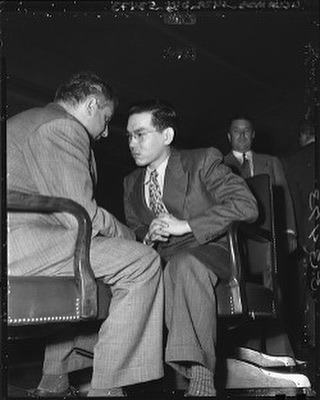
Tomoya Kawakita at his 1948 trial for treason against the United States. Kawakita, a dual US/Japanese citizen born in California, was convicted of treason against the United States for his actions as an interpreter for the Empire of Japan during World War II. His death sentence was commuted to life in prison. He was eventually released from prison by John F. Kennedy in one of his last acts as President, deported to Japan and barred from ever returning to the United States. He remains the last American citizen ever convicted of treason against the United States. [Courtesy of the Los Angeles Times photographic archive, UCLA Charles E. Young Research Library Department of Special Collections, A1713] https://www.instagram.com/p/Bzm_15fpWqz/?igshid=8ysbmtas6uis
19 notes
·
View notes
Text
Top 10 dental clinics in Vietnam
Introduction
A dental vacation to Asian countries is becoming a trend now in the Australian and American communities of people who need dental care. One of the popular country with tourists include Vietnam for the exceptionally low price along with the high-skilled specialists who have many clinical experiences. If you’re planning on coming to Vietnam for your dental holiday in the future, this article is going to help you find out which are the top clinics in Vietnam rated by GCR (the Global Clinic Rating site).
What is GCR?
GCR (Global Clinic Rating) is the rating site for dental established since 2014, only as a beta test, and officially offer the public basic ranking in 2015. As the site offer customers to rate the clinics, GCR provides real-time scores of over 400,000 clinics around the world for people to free access to the wide-range clinics’ database.
In terms of scoring and ranking, GCR collects data on free information given by the customers, official information submitted by the clinics, and GCR evaluation especially for GCR Rank. This score data depends on four pillars: expertise, facilities, services, and feedbacks of customers.
Some clinics may get GCR™ International Accreditation. This accreditation certifies that a clinic has been evaluated by GCR’s expert team, both online score and through a personal visit, and has officially met the international standard.
Dr. Hung & Associates Dental Center
Dr. Hung & Associates Dental Center is the most well-known dental clinic in Vietnam and has been established for over 20 years. They offer high-quality treatment with a full range of services. The center is unique with its own in-house lab with the latest CAD-CAM technique. Not only do they deliver high-quality results but they also offer affordable costs. The experts always uphold ethics, enhance professional skills, work whole-heartedly to provide their customers with a better smile.
Location: 244A Cong Quynh Street, Pham Ngu Lao Ward, District 1, Ho Chi Minh City, Vietnam.
Rose Dental Clinic*
Rose’s staffs are all professional dentists. All of them graduated from the intensive dental program from the best medical university in Vietnam. They constantly adapt to new technologies in the dental field, learn from the leading dental association, and fully attend global conferences about dental care. This is one of the top clinics received GCR International Accreditation is this top 10 clinics list.
Location: 2nd floor, 30-36 Phan Boi Chau Street, Ben Thanh Ward, Distict1, Ho Chi Minh City, Vietnam.
Serenity International Dental Clinic*
Serenity IDC has in total 4 branches across Vietnam, and all of them located in the 4 tourism hubs of Vietnam: Hanoi, Ho Chi Minh City, Nha Trang, and Da Nang. They have the customer’s record saved in all 4 branches, therefore patients can attend their treatment while traveling from North to South Vietnam. Their specialists are known to not only graduated Vietnam’s most prestigious medical university but also went through the extensive training courses and frequently attend enrichment programs in South Korea and Australia.
Location:
16 Chau Long Street, Ba Dinh District, Hanoi, Vietnam.
113 Duong Dinh Nghe Street, Son Tra District, Da Nang, Vietnam.
214/B7 Nguyen Trai Street, District 1, Ho Chi Minh City, Vietnam.
102 Hong Bang Tan Lap, Nha Trang, Vietnam.
Elite Dental Vietnam*
Elite Dental divides its center into two clinics by specific departments: one specializes in orthodontics and general dentistry, the other focuses on implant and prosthodontics. Both clinics operate following the all-in-one paradigm, which means all stages of a dental procedure can be performed at the same location for customer’s convenience. Their clinics have up-to-date technologies, and each clinic includes the tests room, surgery rooms. Standing in the fourth place of GCR Rank is Elite Dental, orthodontics and general dentistry branch in Tran Quoc Thao Street.
Location: 57A Tran Quoc Thao Street, Ward 7, District 3, Ho Chi Minh, Vietnam.
Starlight Dental Clinic - City Center*
Starlight Dental Clinic was established in 1996. The clinic has received many certificates from dental rating sites: 5-star treatment from Whatclinic.com, GCR Internation Accreditation, International Dental Choice from Dental Departures, Excellent Dentistry by Vietnam Economic Times, and the top 6 dental travel service in Ho Chi Minh City.
Location: Starlight City center: 2 Bis Cong Truong Quoc Te Steet, (Turtle Lake) District 3, Ho Chi Minh City, Vietnam.
Starlight Dental Clinic - An Phu*
The second location of Starlight Dental in Ho Chi Minh City.
Location: Starlight An Phu: 24 Thao Dien Ward, District 2, HCMC, Vietnam.
I-DENT Dental Implant Center
I-dent center was established and directed by Dr. Nguyen Hieu Tung--the director of the Developing Dental Success Institute. They offer restorative dental solutions for patients with missing teeth and who wish to regain full, healthy smiles. Their dental implants are topped with aesthetically pleasing restorations for optimal function and natural appearance. With their dedication to patient comfort, they ensure you can enjoy a lasting smile.
Location:
193A-195 Hung Vuong Street, Ward 9, District 5, Ho Chi Minh City, Vietnam.
19V Nguyen Huu Canh Street, Ward 19, Binh Thanh District, HCMC, Vietnam.
Nhan Tam Dental Clinic
Nhan Tam dental was founded in 1998 by Dr. Vo Van Nhan--an expert in dental implantology and cosmetic restoration in Vietnam. Dr. Nhan has a Master’s degree from UCLA, USA, completed Ph.D.’s degree and DDS’ degree. He believes kindness is the most important thing and operates his clinic following the belief. Customers coming to Nhan Tam are not only cared for their dental problems but also their mental health during the dental procedure.
Location: 801-809, 3/2 Street, Ward 7, District 10, HCMC, Vietnam.
Minh Khai Dental Clinic
Minh Khai Dental Clinic was founded in June 2001 under the direct operation and training of Dr. Philippe Guettier with the assistance of French dental experts and other superior partners from the US and Swiss. Minh Khai Dental’s dentists, aside from graduated from medical university in Vietnam, has the chance to learn from the team of senior expert from many countries like France, the United States, and Switzerland who continuously giving them training and advice in difficult dental cases.
Location: 199 Nguyen Thi Minh Khai Steet, District 1, HCMC, Vietnam.
Elite Dental Vietnam - Implant and prosthodontics center
The second center of Elite Dental in Ho Chi Minh which focus on only dental implant and prosthodontics procedures.
Location: 51A Tu Xuong Street, Ward 7, District 3, HCMC, Vietnam.
Conclusion
Above are the top 10 Vietnamese clinics issued by GCR Rank in Vietnam. I hope you have had an overview of the best dental clinics in Vietnam, therefore being able to decide which clinic is most suitable for your needs.
#dentaltourism#dentalcare#smile#dentistry#cosmetic dentistry#dentalmakeover#vietnam#travelvietnam#dentist#dentalassistant#dentalhygiene#dental#medicaltourism#medicaltravel#dentalveneers#smilemakeover#dentalprocedure#dentalcrown#dentalhealth#DentalImplants#dentalwork#dentalholiday#lowcostdental#teeth#lotusdentaltravel
1 note
·
View note